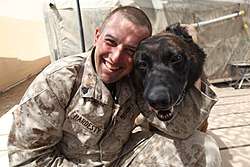Human–canine bond
Human–canine bonding is the relationship between dogs and humans. This bond can be traced back at least 15,000 years ago to the Bonn-Oberkassel dog that was found buried with two humans. For centuries, dogs have been labeled as "man's best friend," offering companionship and loyalty to their human counterparts.[1] This is evident in most homes where dogs are domesticated. Children and adults have cordial relationships with all kinds of dogs.

History

Human–canine bonding was recognized by Boris Levinson,[2] who had an immense influence on the establishment of the field of study. Levinson is known for accidentally discovering the benefits of assisted pet therapy. He found that withdrawn and uncommunicative children would interact positively whenever he brought his dog, Jingles, to their therapy sessions. His discovery was further reinforced by Sam and Elizabeth Corson, who were among the first to research and evaluate pet-facilitated therapy.[3]
In the early 1980s the term 'human–animal bond' was officially coined by Leo K. Bustad, who delivered a summary lecture on the Human-Pet Relationship on October 28, 1983, at the International Symposium in Vienna. This symposium was held in honour of Konrad Lorenz, and during his lecture, Bustad praised him for his work on the human–animal bond and encouraged others to build on Lorenz's work on the subject.[4] In the early 1970s, Konrad Lorenz had developed the field of ethology with his landmark research on the imprinting of behaviours in geese.[5]
Bustad and other pet therapy advocates formed the Delta Society, which was built on the earlier work of Levinson and Croson.[3] In the 1970s and 1980s, national and international conferences led to greater recognition of the human–animal bond. Since then, there has been widespread media coverage of animal-assisted activity and therapy programs and service dog training.[4]
In the United States, over 48% of households have a pet dog.[6]
Concepts

The use of dogs in activities to help humans has become widespread in the last few decades since the 1970s and 1980s. Dogs have been used for service due to their incredible sense of smell with research showing they can smell fear, anxiety and sadness. The use of service dogs in assisting humans range from guide dogs, mobility dogs and medical alert dogs. In some hospitals the use of dogs has been referred to as animal-facilitated therapy (AFT). AFT involves the use of trained, certified animals as part of a medical patient's therapeutic plan. These programs have been shown to promote a healing environment and reduce certain psychological symptoms for patients with a variety of diagnoses, including cancer,[7] seizure alert and detecting peanut allergies. Dogs, better known as “therapy dogs,” are used in hospitals for pet-assisted therapy to provide comfort and affection to people. As a result of the studies by Dr. Samuel Corson pets have become commonplace in nursing homes[8] and other such settings. Persons who suffer from isolation, depression, and mental illness, sometimes to the point where it significantly interferes with day-to-day life find security in an emotional support animal. It is important to remember that those dogs that fall into the emotional support animal category do not require any specific training or screening.[9]
A study conducted by J.S.J Odendaal in 2003 showed that when humans pet dogs, their bodies release oxytocin, a hormone associated with not only happiness, but bonding and affection as well.[10] According to the social support theory, animals are a source of social support and companionship, which are necessary for well-being.[11] Canines' social impact on humans is especially significant for those who tend to be more isolated, such as children with no siblings[12] or elderly persons.[13] In this view, the animal is part of our community and is an important determinant for psychological well-being. According to self psychology, an animal can be a "self-object" that gives a sense of cohesion, support, or sustenance to a person's sense of self. Self-psychology explains why some animals are so crucial to a person's sense of self and well-being.[14] Dog companionship often gives people a sense of purpose by causing them to develop a daily routine and giving them something to look forward to each day.[1] Studies also show owning a dog reduces stress,[15] alleviates anxiety[16] and even can prolong a human's lifespan.[17] Despite the positive relationship, there are instances where dogs have turned on their owner or other humans.[18] The reasons for a dog to break the normally positive social bond are varied and include a background of abuse against the animal, inherent psychological issues of the dog, and where the dog may have been trained for heightened aggression.
See also
References
- "Why Man's Best Friend is Man's Best Friend".
- Pet-Oriented Child Psychotherapy (1969) and Pets and Human Development (1979)
- Catanzaro, T. E. (2003). Section introduction: Human-animal bond and primary prevention. American Behavioral Scientists, 47, 29-30. doi: 10.1177/0002764203255209
- Hindes, L. M. (2003). Historical perspectives on the human-animal bond. American Behavioral Scientists, 47(1), 7-15. doi: 10.1177/0002764203255206
- Nitkin, Patricia. "The Human-Animal Bond", B.C. Cancer Agency, University of British Columbia. Retrieved on 2011-06-19.
- "Pet Industry Market Size & Ownership Statistics". American Pet Products Association.
- "Animal Therapy Has Benefits for Patients—and Healthcare Staff", "Ons Voice", 2018-08-12
- "Dr. Samuel Corson, 88, Dies; Father of Pet-Assisted Therapy", "The New York Times, 1998-03-02
- "Everything You Need to Know About Emotional Support Animals", "American Kennel Club", 2017-06-20
- Odendaal, J.S.J.; Meintjes, R.A. (May 2003). "Neurophysiological Correlates of Affiliative Behaviour between Humans and Dogs". The Veterinary Journal. 165 (3): 296–301. doi:10.1016/S1090-0233(02)00237-X. PMID 12672376.
- Beck, Alan M (2003). "Future Directions in Human-Animal Bond Research". American Behavioural Scientist. 47 (1): 79–93. doi:10.1177/0002764203255214.
- Hodgson, K.; Barton, L.; Darling, M.; Antao, V.; Kim, F.A.; Monavvari, A. (2015). "Pets'Impact on Your Patients' Health: Leveraging Benefits and Mitigating Risk". The Journal of the American Board of Family Medicine. 28 (4): 526–534. doi:10.3122/jabfm.2015.04.140254. PMID 26152446.
- "Why Man's Best Friend is Man's Best Friend".
- Brown, Sue-Ellen (2011) "Self Psychology and the Human-Animal Bond: An Overview," The Psychology of the Human-Animal Bond, part 2, pp. 137-149.
- Allen, Karen; Shykoff, Barbara; Izzo, Joseph (2001). "Pet ownership, but not ace inhibitor therapy, blunts home blood pressure responses to mental stress". Hypertension. 38 (4): 815–820. doi:10.1161/hyp.38.4.815. PMID 11641292.
- Nagengast, S.L.; Baun, M.M.; Megel, M.; Leibowitz, J.M. (December 1997). "The effects of the presence of a companion animal on physiological arousal and behavioral distress in children during a physical examination". Journal of Pediatric Nursing. 12 (6): 323–330. doi:10.1016/s0882-5963(97)80058-9. PMID 9420370.
- Ingraham, Christopher. "Own a dog and live longer, new research says". The Washington Post.
- "Dog Bite Statistics (How Likely Are You To Get Bit?)". www.caninejournal.com. Retrieved 2019-06-26.
Further reading
- Jon Franklin (1 September 2009). The Wolf in the Parlor: The Eternal Connection Between Humans and Dogs. Macmillan. ISBN 978-0-8050-9077-2. Retrieved 28 May 2011.
- Child development: Endenburg, Nienke & vanLith, Hein A. (2010). "The influence of animals on the development of children" The Veterinary Journal
- Daly, Beth; Morton, L. L. (2009). "Empathetic Differences in Adults as a Function of Childhood and Adult Pet Ownership and Pet Type". Anthrozoos. 22 (4): 371–382. doi:10.2752/089279309x12538695316383.
- Health; Gillum, Richard F.; Obisesan, Thomas O. (2010). "Living with Companion Animals, Physical Activity and Mortality in a U.S. National Cohort". Int. J. Environ. Res. Public Health. 7 (6): 2452–2459. doi:10.3390/ijerph7062452. PMC 2905559. PMID 20644682.
- Animal-assisted; Animal-assisted; Friesen, Lori (2009). "Exploring Animal-Assisted Programs with Children in School and Therapeutic Contexts". Early Childhood Education Journal. 37 (4): 261–267.
| Wikiversity has learning resources about Human-animal bond |